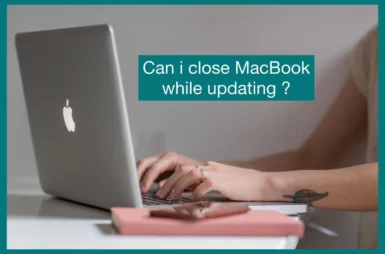Ever wondered if it’s okay to close your MacBook while it is updating? If yes, you are in the right place.
This article will discuss potential risks and effective measures to ensure a smooth updating process. Upgrade your knowledge and keep your MacBook updated!
Can You Close Your MacBook While Updating?
If you close the MacBook while updating, there may be dangers and problems. Updates are essential for improving functionality, security, and bug fixes. Shutting down abruptly during the update procedure could damage system files, leading to errors or even data loss.
Apple advises against closing the lid while performing updates to guarantee a seamless and effective installation. Instead, wait for the update to finish while the MacBook is powered on and open.
If you mistakenly closed it, open it and start the update again. Prioritizing a stable update process gives you a seamless and effective MacBook experience by protecting your device and ensuring optimal operation.
What Happens if You Close Your MacBook While It’s Updating?
There may be several negative effects if you close your MacBook while updating, some of which may be very significant. When you start a system update, the operating system installs new files and modifies existing ones.
This procedure is interrupted midway if the MacBook is abruptly shut off, and several problems could result:
1. Update Incomplete
The update procedure won’t be completed, which could lead to incomplete installations of crucial system files.
2. Software Corruption
Interrupted updates may result in damaged system files, which may result in malfunctioning software and unstable systems.
3. Boot Issues
Incomplete or corrupted updates may make it difficult for your MacBook to start up correctly, resulting in booting problems or a non-responsive system.
4. Data Loss
Interrupting an update results in data loss or harm to already existing files on the system.
5. Increased Vulnerability
Because outdated software doesn’t take advantage of the most recent security updates and patches, your MacBook is more susceptible to security risks.
Letting the upgrade process finish completely is crucial to prevent these potential issues. When updating your MacBook, ensure it is always plugged in and has a solid internet connection.
When you reopen your MacBook after unintentionally closing it during an update, you should immediately restart the upgrade.
Best Practices for Installing Updates on Your MacBook
Updating your MacBook is essential for ongoing peak performance, security, and access to the newest features. Follow these essential steps to guarantee a smooth upgrade procedure and prevent potential problems:
1. Backup Your Data
Completely back up your crucial files and data before beginning any updates. If something goes wrong during the updating process, you can recover your data using this method.
2. Check for Stable Internet Connection
Ensure your MacBook is linked to a dependable and stable internet connection by checking for a stable one. Typically, updates are downloaded from Apple’s servers, so a steady connection is necessary to prevent delays.
3. Connect to Power
While updating, plug your MacBook into a power source. This stops the device from shutting down during installation due to a low battery.
4. Remain Patient
Some upgrades, particularly significant macOS updates, can take some time to install. Even if it appears to be taking longer than anticipated, show patience and refrain from interfering.
5. Close Unnecessary Programs
Before running the update, close all unnecessary processes and programs. Conflicts and other potential problems during the upgrade can be avoided.
6. Follow Apple’s Directions
Pay close attention to any instructions or prompts that Apple gives you while updating your device.
7. Avoid Forced Shutdown
Never force your MacBook to shut down while an update is running. Even if the update appears to be stalled, give it time to finish normally. Data loss and system instability can result from interrupting the procedure.
8. Check for Adequate Disk Space
Ensure your MacBook has enough free disk space for the upgrade by checking for adequate disk space. Running out of room during installation could cause issues.
9. Regularly Update Your MacBook
To regularly update your MacBook, turn on automatic updates in System Preferences. The latest security patches and bug fixes are always available with regular updates.
10. Verify Compatibility
Before updating any third-party gear or software connected to your MacBook, be sure it is compatible with the most recent version of macOS.
By adhering to these best practices, you can maintain a healthy, efficiently operating MacBook with the most recent software upgrades and improved security features.
Conclusion
For optimal performance and security, your MacBook has to be updated. Have a reliable internet connection, backup your data, and connect to power.
During the update process, patience is essential; never force a shutdown. By following best practices, you can have a smooth upgrade experience with your MacBook’s newest security and functionality.



